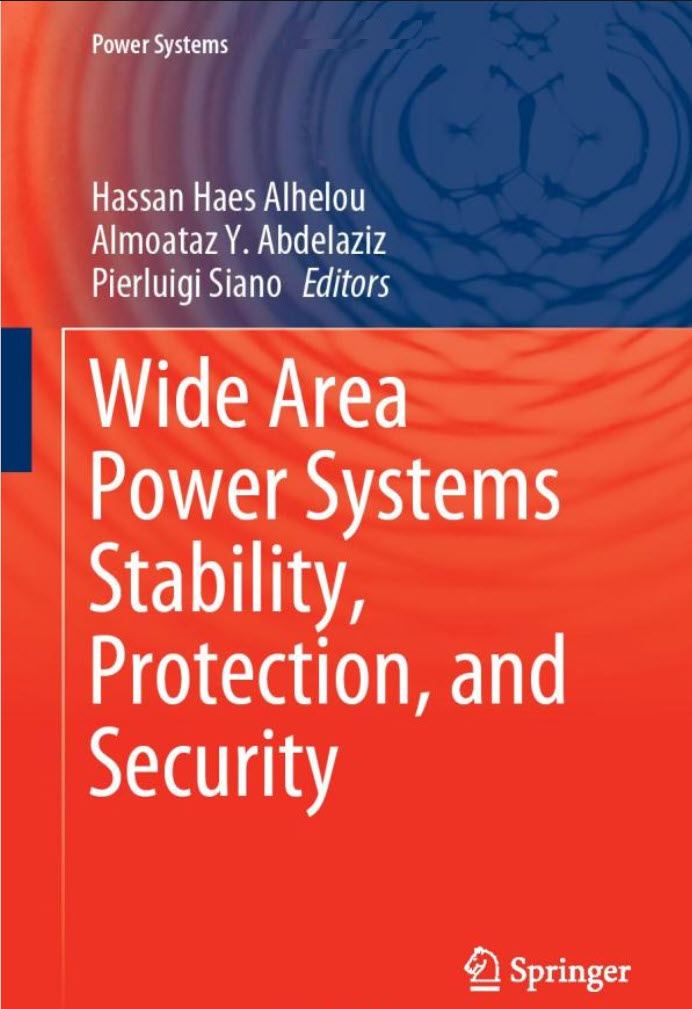Book review by Alexander Apostolov, USA
1st Edition 2021

The electric power industry is going through a very difficult period of transitioning towards a grid with a very high penetration of renewable energy resources many of which are connected through inverters which dramatically changes the behavior of the system during abnormal conditions which has an impact on the reliability and stability. That is why it is becoming increasingly important to have a good understanding of what these changes mean and how we can mitigate them.
The more than 600 pages of the book are organized in 22 chapters that cover different aspects of wide area power systems and how the protection and control can help ensure the system stability and reliability. The chapters are authored by many specialists from all over the world and combined into a single volume.
The editors of the book are Dr. Hassan Haes Alhelou, a faculty member at Tisheen University, Lattakia, Syria, Professor Almoataz Youssef Abdelaziz from Ain Shams University, Cairo, Egypt and Professor Pierluigi Siano who is also Scientific Director of the Smart Grids and Smart Cities Laboratory with the Department of Management & Innovation Systems, University of Salerno, Italy. They have many years of academic and research experience related to the protection, automation and control of the electric power systems as part of the smart grid.
The first two chapters represent a comprehensive review of wide-area protection, control and monitoring systems and their applications for Future Power Systems.
The third chapter is focused on the available information and communication infrastructures in modern wide-area system.
The next two chapters concentrate on the use of phasor measurement units in wide-area monitoring systems and their optimal selection.
Chapter 6 looks at the impact of wind power generation penetration on power system oscillations and innovative methods for load frequency control for their damping. The oscillations topic is further analyzed in the following chapter from the perspective of large, interconnected power systems.
Electromechanical mode estimation in power system using a novel nonstationary approach is discussed in Chapter 8 with the next chapter looking at the use of wide area signal from wind farm for the improvement of small signal stability of pumped storage hydropower stations. Chapters 10 and 11 consider the impact of wind generation on low frequency oscillations and frequency stability.
The following three chapters focus on issues related to voltage stability assessment and control based on wide area measurements.
Chapter 15 analyzes the impact of stressed system conditions on distance relays, followed by a proposal for the use of PMU measurements-based machine learning methods for real-time voltage stability monitoring in the next chapter.
The next two chapters concentrate on the fault analysis of a wide area transmission system and its three-phase state estimation, as well as data-driven wide-area.
Chapters 19 and 20 shift to techno-economic analysis of WAMS based islanding detection and estimation for microgrids in a smart grid environment.
The last two chapters concentrate on the resilience in wide area monitoring systems and intrusion detection systems for cyber-physical security for the smart grid.
As can be seen from the content, this book covers a wide range of topics and proposes some new control and protection schemes to improve the overall stability and security of future power systems with high penetration of distributed renewable energy resources in a smart grid environment.
Wide Area Power Systems Stability, Protection, and Security
by Hassan Haes Alhelou, Almoataz Abdelaziz, Pierluigi Siano
Publisher: Springer; 1st ed. 2021 edition (09 22, 2020)
ISBN-10: 3030542742
ISBN-13: 978-3030542740








